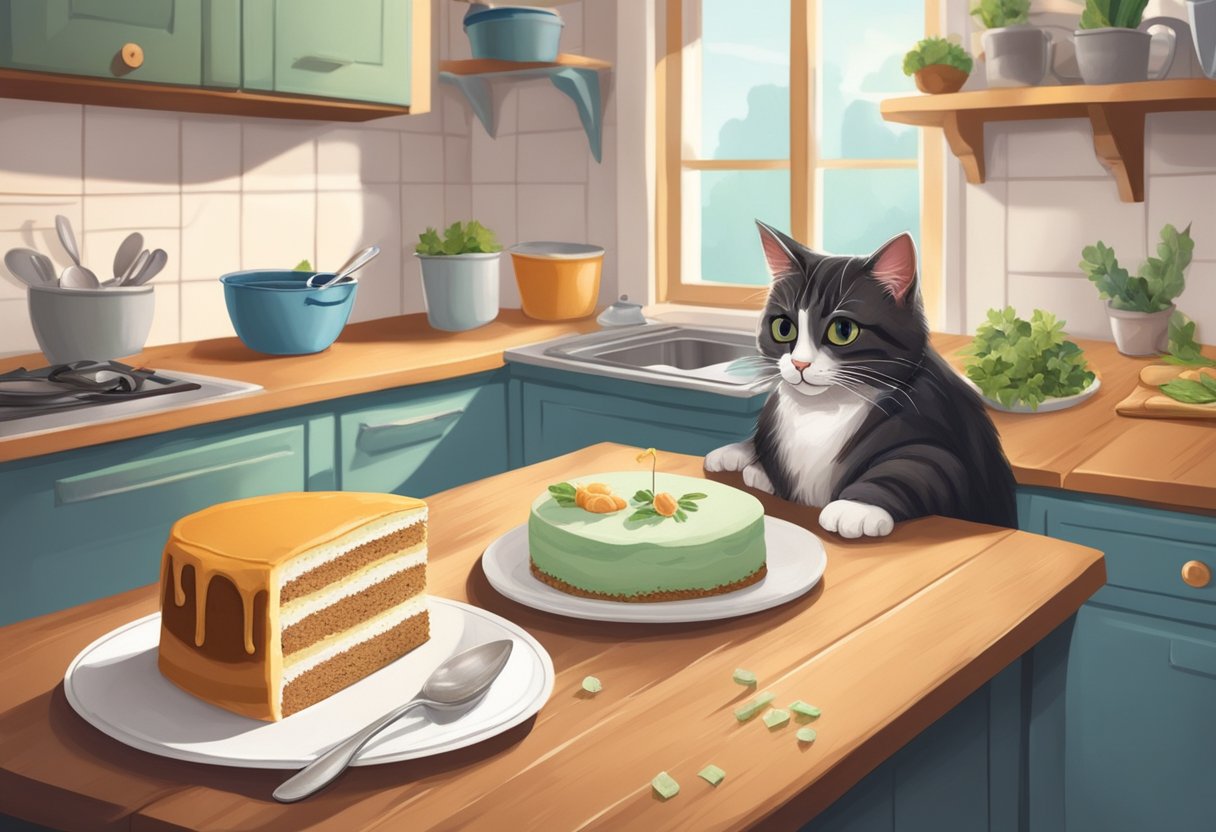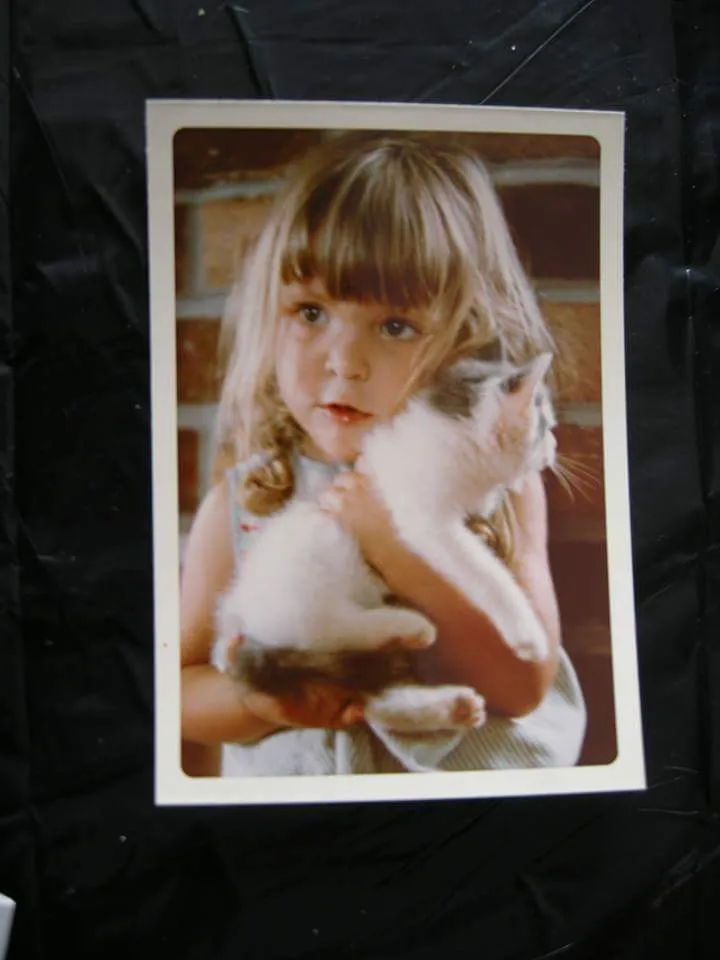How to Make a Special Treat for Your Feline Friend • Kritter Kommunity
NEED A CAT BIRTHDAY CAKE RECIPE?
Are you looking for a special treat to celebrate your furry friend’s birthday? You’re in the right place as I am a cat parent and this post is all about cat birthday cake recipe; how to make a special one! Not to mention, there are several other blogs on Kritter Kommunity about cat parties. When you are done here, check out names for a cat party and how to have a cat party.🎈🐈⬛
With a few simple ingredients and some creativity, you can create a delicious and healthy cake that your cat will love.
Plus, making a cake from scratch ensures that you know exactly what your cat is eating, without any added preservatives or artificial ingredients.
In the cat birthday cake recipe blog post, you’ll learn:
- How to Make a Special Treat for Your Feline Friend: A Homemade Cat Birthday Cake Recipe
- Understanding Cat Nutrition: Essential Nutrients, Common Allergies, and Dietary Needs
- Choosing the Right Ingredients: Protein Sources, Sweeteners, and Cat-Friendly Flavors
- Recipe Basics: Preparation, Baking Tips, and Safe Food Handling
- Decorating Your Cat’s Birthday Cake: Edible Decorations, Festive Ideas, and Presentation Tips
- Serving the Cake: Portion Sizes, Presentation Tips, and Catering to Multiple Cats
- Storing Leftovers: Refrigeration Guidelines and Freezing Tips for Later Use
And without further ado, let’s pounce in!
WHAT CAN CATS EAT FOR THEIR BIRTHDAY?
When it comes to making a cat birthday cake, there are a few important things to keep in mind. First and foremost, you’ll want to make sure that all of the ingredients are safe for your cat to eat. Avoid any ingredients that are toxic to cats, such as chocolate, onions, garlic, and grapes. Stick to cat-friendly ingredients like tuna, chicken, and sweet potato, which are not only safe but also tasty and nutritious for your furry friend.
| Safe for Cats | Not Safe for Cats |
|---|---|
| 1. Cooked Meat (e.g., chicken, turkey) | 1. Onions & Garlic |
| 2. Cooked Eggs | 2. Chocolate |
| 3. Cooked Fish | 3. Grapes & Raisins |
| 4. Cooked Vegetables (e.g., pumpkin, carrots) | 4. Xylitol (artificial sweetener) |
| 5. Plain Cooked Rice | 5. Caffeine (e.g., coffee, tea) |
| 6. Plain Cooked Pasta | 6. Alcohol |
| 7. Plain Yogurt | 7. Raw Dough |
| 8. Blueberries | 8. Avocado |
| 9. Watermelon (seedless) | 9. Macadamia Nuts |
| 10. Cantaloupe | 10. Dairy Products (in large quantities) |
Safe foods for cats include cooked meats, eggs, fish, and certain cooked vegetables in moderation. However, foods like onions, garlic, chocolate, grapes, raisins, xylitol, caffeine, alcohol, raw dough, avocado, macadamia nuts, and large quantities of dairy products should be avoided as they can be toxic or harmful to cats. Always consult with a veterinarian before introducing new foods to your cat’s diet or using them in special treats like a birthday cake.
Are Black Olives Bad For Cats?
From Paws to Tentacles: Can Cats Eat Squid?
Can Cats Eat Jam? Debunking the Myths and Unraveling the Truth
Can Cats Drink Chocolate Milk? Decoding Disapproved Beverages
DO CATS GET PICKY WITH FOOD?
Another important consideration is the texture of the cake. Cats have different preferences when it comes to texture, so you’ll want to choose ingredients that your cat enjoys. For example, some cats prefer soft and moist cakes, while others prefer crunchy treats.
You can experiment with different textures and ingredients to find the perfect cake recipe for your cat’s taste buds.
Understanding Cat Nutrition



Cats have unique nutritional requirements that must be met to maintain their health and well-being. Understanding what nutrients your cat needs and how to provide them with a balanced diet is essential to keeping them healthy.
Can Cats Eat Mussels Safely? Meow Moderation
Can Cats Eat Pistachio Ice Cream Safely?
Can Cats Eat Raw Chicken Bones Safely?
Can Cats Eat Maraschino Cherries? Everything You Need to Know
WHAT ARE THE NUTRITIONAL NEEDS FOR INDOOR CATS?
Cats require a diet that is high in protein and fat, with moderate amounts of carbohydrates. They also need specific vitamins and minerals to support their overall health. Here are some of the essential nutrients that your cat needs:
- Protein: Cats are obligate carnivores, which means they require a diet that is high in animal protein. Protein is necessary for building and repairing tissues and supporting a healthy immune system.
- Fat: Fat is an important energy source for cats and also helps to keep their skin and coat healthy.
- Carbohydrates: While cats don’t require carbohydrates in their diet, they can provide a source of energy and fiber.
- Vitamins: Cats require specific vitamins, including vitamin A, vitamin D, and vitamin E, to support their overall health.
- Minerals: Cats also need minerals like calcium, phosphorus, and potassium to maintain strong bones and teeth and support other bodily functions.
Common Food Allergies in Cats
Just like humans, cats can develop food allergies. Common food allergens for cats include beef, dairy, fish, and chicken. If your cat is experiencing symptoms like vomiting, diarrhea, or skin irritation, it may be a sign of a food allergy. If you suspect that your cat has a food allergy, it’s important to speak with your veterinarian to determine the best course of action.
In conclusion, understanding your cat’s nutritional needs is essential to keeping them healthy. By providing a balanced diet that meets their specific requirements and monitoring their health for any signs of food allergies or other issues, you can help ensure that your cat stays happy and healthy for years to come.
Choosing the Right Ingredients
When it comes to baking a cake for your cat’s birthday, choosing the right ingredients is crucial to ensure that your feline friend gets all the nutrients they need. Here are some tips that will help you select the right ingredients for your cat’s birthday cake.
Selecting a Protein Source
Cats are obligate carnivores, which means they need a diet that is rich in protein. When selecting a protein source for your cat’s birthday cake, choose high-quality meat, such as chicken or turkey. You can also use canned tuna as a protein source, but make sure it is packed in water and not oil.
Opting for Natural Sweeteners
While cats have a sweet tooth, they cannot digest sugar like humans can. Therefore, it is important to opt for natural sweeteners when making a cake for your cat. You can use honey or maple syrup as a natural sweetener. Avoid using artificial sweeteners such as xylitol, as they can be toxic to cats.
Picking Cat-Friendly Flavors
When it comes to picking flavors for your cat’s birthday cake, it is important to choose flavors that are safe for cats. Some cat-friendly flavors include salmon, chicken, and tuna. You can also use catnip to add flavor to your cat’s cake.
Recipe Basics
Preparation Overview
Making a birthday cake for your cat can be fun, especially if you take photos to share with your cat lovin’ pals.
Before you start, make sure you have all the necessary ingredients and equipment. Read through the recipe carefully to ensure you understand each step. Take note of any special equipment or techniques required, such as a food processor or a springform pan.
It’s important to measure your ingredients accurately to ensure the cake turns out right. Use measuring cups and spoons to measure dry ingredients, and a kitchen scale for wet ingredients. Make sure you follow the recipe’s instructions carefully, and don’t be afraid to ask for help if you’re unsure about anything.
Creating a cake specifically for cats involves using ingredients that are safe and healthy for them. Here’s a simple cat-friendly cake recipe:
WHAT SPECIAL TREAT CAN I GIVE ME CAT FOR HIS BIRTHDAY?
Make your cat a cat-friendly cake for his birthday! Here is your step-by-step guide showing you how.
Cat-Friendly Tuna Cake
Ingredients:
- 1 can of tuna (in water, not oil; make sure it’s plain and unsalted)
- 1 egg
- 1/4 cup of flour (you can use regular flour or whole wheat flour)
- 1 tablespoon of grated carrot (optional)
- 1 tablespoon of finely chopped parsley (optional, for added freshness)
- Catnip (optional, for added appeal to your cat)
Equipment:
- Mixing bowl
- Fork or spoon for mixing
- Small cake pan or muffin tin
- Non-stick spray or parchment paper
Directions:
1. Preheat Oven:
- Preheat your oven to 350°F (175°C).
2. Prepare the Cake Batter:
- Drain the tuna and place it in a mixing bowl.
- Add the egg, flour, grated carrot, parsley, and a pinch of catnip (if using) to the bowl with the tuna.
- Mix all the ingredients thoroughly until well combined. You should have a thick batter-like consistency.
3. Bake the Cake:
- Lightly grease a small cake pan or muffin tin with non-stick spray or line it with parchment paper.
- Spoon the cake batter into the pan or divide it evenly among the muffin cups.
4. Bake:
- Place the cake pan or muffin tin in the preheated oven.
- Bake for about 15-20 minutes or until the cake is firm and golden brown on top.
5. Cool and Serve:
- Once baked, allow the cake to cool completely.
- Remove the cake from the pan or muffin tin.
6. Serve to Your Cat:
- Cut the cake into small, bite-sized pieces suitable for your cat.
- Offer the cake to your feline friend as an occasional treat or special reward.
While this cake is made with safe ingredients for cats, it should be given in small portions and not as a substitute for their regular diet.
Baking Time and Temperature
The baking time and temperature will depend on the recipe you choose. Most cat birthday cake recipes take around 20-30 minutes to bake at 350°F. However, some recipes may require a longer or shorter baking time, so make sure you follow the recipe’s instructions carefully.
To check if the cake is done, insert a toothpick into the center of the cake. If it comes out clean, the cake is ready. If it comes out with batter on it, bake the cake for a few more minutes and check again.
Safe Food Handling
When making a cat birthday cake, it’s important to practice safe food handling. Wash your hands and any equipment you use thoroughly before and after handling food. Use separate cutting boards and utensils for raw meat and other ingredients.
Make sure you use fresh ingredients and check their expiration dates. Store any leftovers in an airtight container in the refrigerator and discard any leftovers that have been sitting out for more than two hours.
By following these basic guidelines, you can ensure that your cat’s birthday cake is not only delicious but also safe to eat.
Decorating Your Cat’s Birthday Cake
Once you have baked your cat’s birthday cake, it’s time to decorate it! Here are some ideas for making your cat’s cake look festive and fun.
Edible Decorations
One way to decorate your cat’s cake is to use edible decorations. You can use cat-friendly ingredients like tuna, chicken, or catnip to create decorations that your cat will love. Here are some ideas:
- Tuna flakes: Sprinkle some tuna flakes on top of your cat’s cake for a simple and tasty decoration.
- Chicken strips: Cut some cooked chicken into thin strips and arrange them in a pattern on top of the cake.
- Catnip: Sprinkle some dried catnip on top of the cake for a fun and playful touch.
Making the Cake Festive
Another way to decorate your cat’s cake is to make it look festive. Here are some ideas for making your cat’s cake look extra special:
- Use a candle: If your cat is comfortable with candles, you can place a small birthday candle on top of the cake. Just be sure to supervise your cat closely while the candle is lit.
- Add a message: You can use a small amount of cat-safe food coloring to write a message on top of the cake. Try writing “Happy Birthday” or your cat’s name.
- Use a special plate: Serve your cat’s cake on a special plate to make it look extra festive. You can use a plate with a cat design or a bright color to make it stand out.
Remember to always use cat-friendly ingredients when decorating your cat’s cake. Avoid using any ingredients that could be harmful to your cat, such as chocolate or artificial sweeteners. With a little creativity, you can make your cat’s birthday cake look and taste amazing!
Serving the Cake
Portion Sizes
When it comes to serving the cat birthday cake, it’s important to remember that cats have smaller stomachs than humans. Therefore, it’s best to keep the portion sizes small. A slice of cake about the size of a quarter or half dollar coin should be enough for a single serving.
If you have multiple cats, you can cut the cake into smaller pieces and serve them individually. Alternatively, you can make cupcakes instead of a full cake, which allows for easier portion control.
Presentation Tips
Presentation is key when it comes to serving a cat birthday cake. After all, you want to make it look as appetizing as possible for your feline friend. Here are some presentation tips to keep in mind:
- Use a small, cute plate to serve the cake on. You can even purchase special cat-themed plates to make it extra festive.
- Add a little bit of catnip to the top of the cake to make it more enticing for your cat.
- Consider adding a small candle to the top of the cake for a cute photo op. Just be sure to remove it before serving the cake to your cat.
- If you’re feeling extra creative, you can use cat-shaped cookie cutters to cut the cake into fun shapes before serving.
Remember, the most important thing is to make the cake look and taste great for your cat. With a little bit of effort, you can create a special treat that your feline friend will love.
Storing Leftovers
After your cat’s birthday celebration, you may have some leftover cake. Here are some guidelines for storing it properly so that it stays fresh and safe for your cat to eat.
Refrigeration Guidelines
If you plan to eat the leftover cake within a few days, store it in an airtight container in the refrigerator. Make sure to cover the container with plastic wrap or a lid to prevent air from getting in. The cake should be consumed within three to four days, and you should check it for any signs of spoilage before serving it to your cat.
Freezing for Later Use
If you have more cake than you can consume within a few days, consider freezing it for later use. Wrap the cake tightly in plastic wrap or aluminum foil and place it in a freezer-safe container. Label the container with the date and contents so that you can easily identify it later.
When you’re ready to serve the cake, thaw it in the refrigerator overnight. You can also thaw it at room temperature for a few hours, but make sure to check it for any signs of spoilage before serving it to your cat.
Wrapping up, this post shared a special homemade cat birthday cake recipe perfect for celebrating your furry friend’s birthday.
For further inspiration on cat-themed celebrations, visit Creative Flavors: Unique Twists on Cat Shaped Cake Recipes where you’ll discover human cakes shaped as cats.
Have a purrfect time and enjoy the pawty!
Lisa Illman is the Founder of Kritter Kommunity, LLC. She has a tuxedo adult cat and has had him since he was a baby kitten. Before her cat Finnegan, Lisa had had two FIV-positive cats for over a decade. They inspired Lisa to invent a cat enclosure and a portable catio so they could safely sit outside and enjoy fresh air and sunshine. Lisa had a Poodle and a parakeet growing up. She currently loves to pet-sit for her neighbors’ dogs and cats.









Why is Kritter Kommunity Your Trusted Partner?
Our mission at Kritter Kommunity is to promote happy and healthy lives for pets and their owners. We specialize in Barkitecture and designing tips for pet-friendly homes, utilizing the natural instincts of cats, dogs, and small critters to create a home life that pets and people love. From tips on pet care to reviews on pet toys and furniture, we are a go-to source for all things cats, dogs and small critters. Join us in celebrating the joys of pet ownership and providing the best possible lives for our furry friends.
